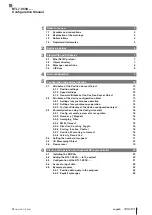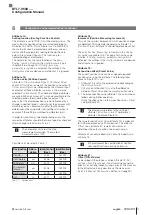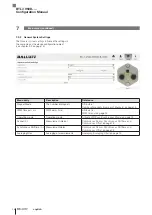
www.balluff.com
13
english
5.1.3 General attributes of the
Position Sensor
Object
Attribute 41:
Measurement status (
Operating Status
)
This attribute contains information on the various statuses
of the encoder.
Bit 0 shows the current direction of movement. If the bit is
0 (FALSE), the position value is moving in a positive
counting direction. If it is 1 (TRUE), it is moving in a
negative counting direction.
Bit 1 shows whether scaling is active. If this bit is deleted,
scaling is deactivated and BTL7-V50D-… outputs raw
values in this case. Scaling is activated if the bit is set.
Attribute 42:
Measurement steps (
Physical Resolution Span
)
This attribute can only be read and it returns the number
of physical measurement counts over the nominal length
(in µm).
Attribute 43:
Number of turns (
Number of Spans
)
The number of turns is shown here because the
Position
Sensor Object
is also valid for rotary encoders. For the
BTL7-V50D-…, the return value is always 1. The attribute
can only be read.
Attribute 44:
Alarms (
Alarms
)
The attribute
Alarms
shows whether there is a malfunction
disturbing determination of the position value. The alarm
remains active until the error is rectified and the device
supplies a valid position value again. The only active bit
is the
Flag Position Error
. It is set if position determination
is not possible. This is the case, for example, if the
corresponding magnet is no longer in the measurement
range.
In the
Flexible Magnet Mode
all positions for a defined time
are invalid if the number of magnets changes. In this case,
the
Position Error
is also set.
5
Configuration and parameterization (continued)
5.2
Attributes of the device configuration object
General sensor settings are made in the device
configuration object. This is a manufacturer-specific object
with only one instance.
Attributes of the device configuration object (class
in the appendix on page 34 for an overview
of attributes.
5.2.1 Settings for synchronous operation
The BTL7-V50D-… can work in synchronous operation in
which internal measurements are triggered with clocked
synchronization. The time parameters must be set for this.
Activate CIP-Sync (
Synchronous Mode
)
If this BOOL is set to TRUE (1), the BTL7-V50D-… works
in synchronous mode. The parameters
Synchronous
Period
,
Synchronous Shifttime
and
Synchronous Offse
t
must be correctly set for this, and control take place in the
correct timing from the point of view of the control system.
Synchronous Period
,
Synchronous Shifttime
and
Synchronous Offset
Fig. 5-1: Timing synchronization
So-called Sync0 impulses are generated by an internal
timer for timing synchronization using CIP Sync. For
cyclical, timing synchronous operation, the BTL7-V50D-…
must know the expected
Synchronous Period
(see Fig. 5-1).
Attribute 4
Synchronous Offset
can be used to move the
start of the internal measurement procedure in relation to
the Sync0 time. A further delay can be set in the internal
measurement process using
Synchronous Shifttime
.
Detection of the position takes place at this time.
In conjunction with the time for measurement
value processing and output, this results in the
Minumum Cycle Time.
The values of attributes 2 to 5 have the unit
nanoseconds (ns).
BTL7-V50D-…
Configuration Manual
Summary of Contents for Ethernet/IP BTL7-V50D Series
Page 1: ...BTL7 V50D Konfigurationshandbuch deutsch...
Page 2: ...www balluff com...
Page 36: ...BTL7 V50D Configuration Manual english...
Page 37: ...www balluff com...
















































